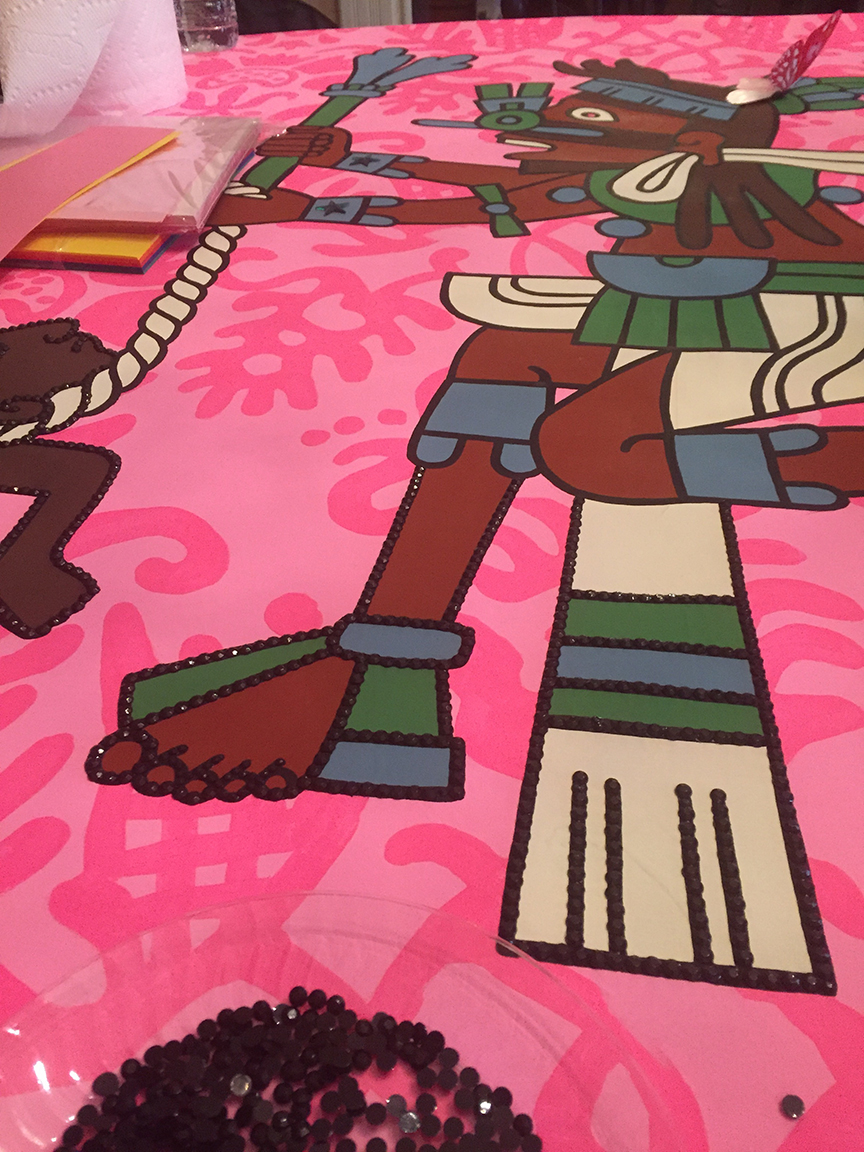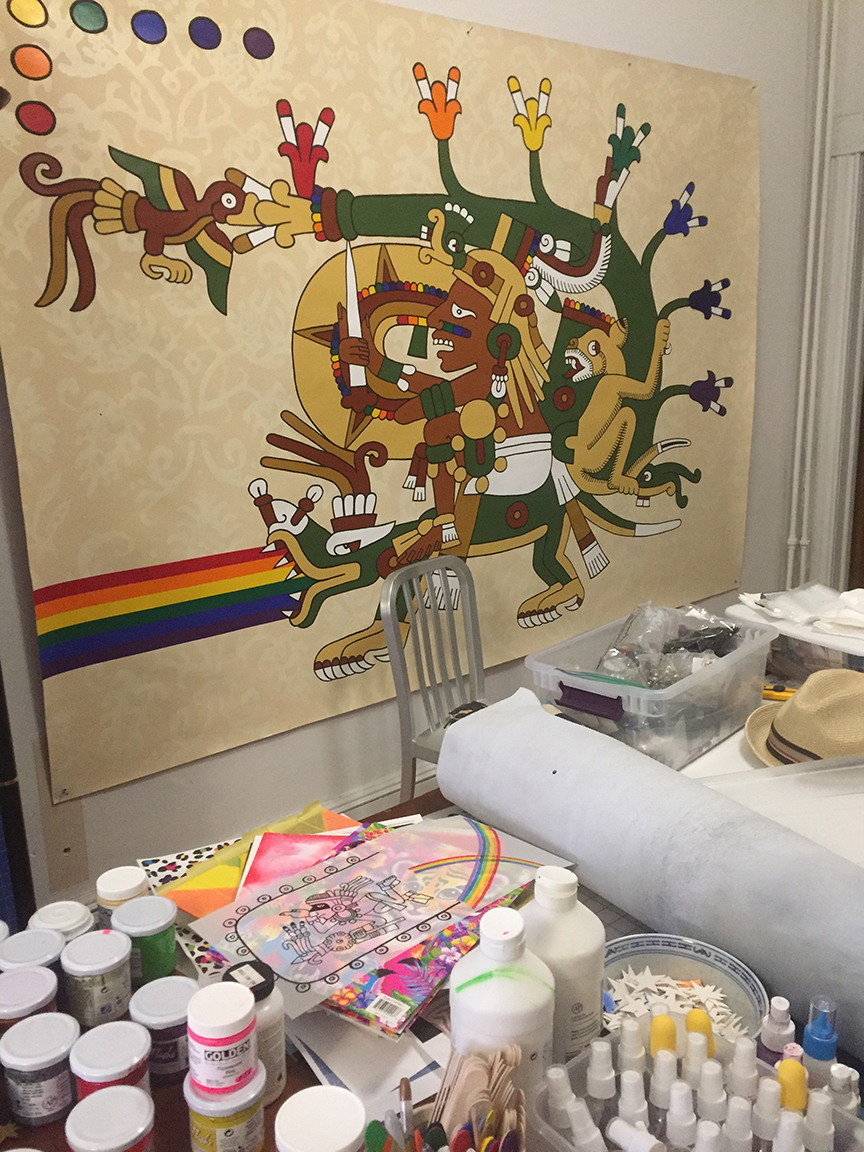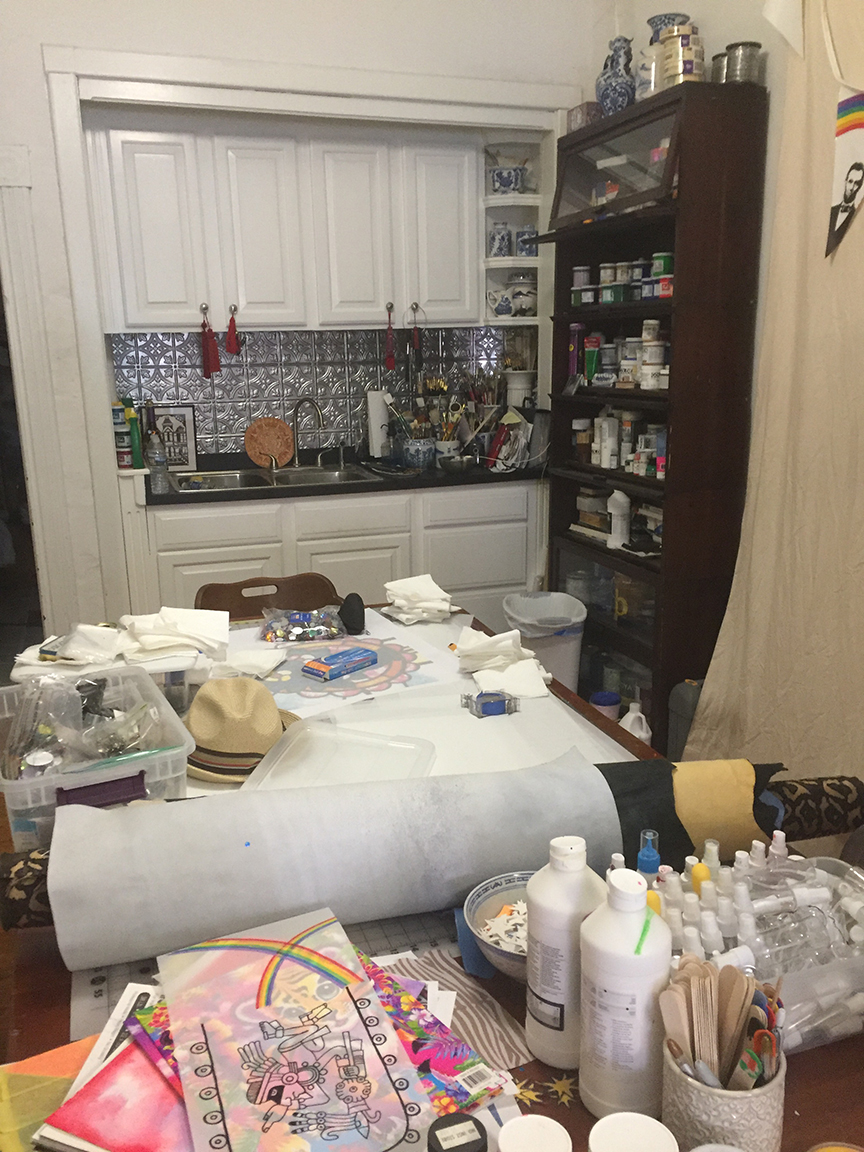Amy Boone-McCreesh visits the Old Goucher Studio of René Treviño
René Treviño came to Baltimore in 2003 to attend MICA for Graduate School. I first met him during a tour of the Creative Alliance in 2009, where he was a resident at the time. René is a sparkling staple in the Baltimore art community—formally acting as Exhibitions Manager at School 33 Art Center and now teaching at Towson University and MICA.
Since arriving in Baltimore he has maintained a consistent and impressive artistic practice. Treviño is currently represented by the Erin Cluley Gallery in Dallas, Texas. We met the day after the only substantial snow of this winter, in his home studio in Baltimore. René dazzled me with rhinestones as we talked about cats, his time in Texas and New York, and carving out a place in history for the underrepresented.
 CODEX, Twins, 2016
CODEX, Twins, 2016
acrylic and latex on Mylar, 30 x 40 in
Where did you grow up?
I grew up in Texas, we moved all over the place. My dad was a manager for JC Penney for a while, and they kept promoting him, which meant a full scale move every year or two. When I was in middle school, we finally settled in Lake Jackson, Texas. Texas has a much larger Mexican population than the rest of the U.S., so that aesthetic, laden with the Catholic iconography that I would see at church or in my grandmothers’ homes, is a huge influence. There is a specificity to the way that we do things in Texas that is still very much in my head.

What is the driving force behind your work?
I am such a consumer of history and popular culture and I just don’t see myself represented in any of that. It would be so nice to see a story like mine, with people that look like me. I don’t get to see my experience in the things that I read or watch. One of my main functions is to be a voice for queer Mexican-Americans. I’m a double minority in a world that is attacking minorities in general. Whoever wins in history generally gets to tell the story. By going back and tweaking and changing history in my art, I can broaden the conversation…I can be an active part of that conversation.
What is your biggest struggle in the studio?
Truthfully it’s that I never have enough time. I have dedicated days for my studio practice but life happens and responsibilities and the things you have to do to be a citizen of the world. So often it just feels like there’s not enough time to physically be here, even though it is my favorite thing and I try to do it as much as possible. It’s nice to work at home, it takes away the barriers. If I have 45 minutes I can just pop in here and do something. I can sneak in laundry or dinner when I am waiting for an area of paint to dry, there’s a nice back and forth.

Put the following terms in order of importance to your studio practice: Form, Concept, Process.
I want it to be a perfect pie chart with three even slices…but probably concept first, because I do want the work to have a conceptual base- the paintings are about something, a bending of history. I am inserting myself into places where I wasn’t originally. I’m very specific about the materials that I use and the way that I use them, so process would probably be second. Form might be last, but not really…scale is important, color is important, composition is important—it’s all considered.

Was there ever a time when you felt like you couldn’t keep making work? If so, what helped you to keep going?
When I was in New York I got a little lost. I moved there to go to Parsons School of Design because I wanted to be a fashion designer. I had gone to Texas A&M University for five years, I was studying theater there, specifically design, and I never graduated. I was really close but never did. So I decided to transfer to Parsons, much to my parents chagrin. They were really upset, but I did it. It was fantastic, but my parents had already helped me with school and I had siblings, and I realized really quickly how expensive private art school is. I took a leave of absence that ended being about four years.
During that time I worked a lot of theater jobs. I worked at the Julliard School, The New York Shakespeare Festival, and several Broadway costume shops. We would make costumes for Disney on Ice or Broadway shows. During that time, I got mixed up. I wasn’t really making any work at all because I spent all day making costumes for other people. An aspect of my creative self was being fulfilled because I was making stuff, but it wasn’t my work that I was making. Also, that city is a non-stop hustle. I got really depressed and it took a while to realize that the reason I was depressed was that I needed to create. So, I transferred to the School of Visual Arts. Once that happened, it has been sort of non-stop.

Do you have any routines, rituals, or coping mechanisms that you use regularly in your studio practice?
No, I listen to music and podcasts. I started listening to some of the Great Courses series. I am listening to one now about ancient Mesoamerica on Audible. I end up taking notes in my sketchbook of things I want to remember and look up; it feeds right back into the work.
Do you have any hobbies or interests outside of your studio practice that help keep you sane?
My husband (Paul Frey) and I watch a lot of films; we go to the movies a lot. In a way though, everything feeds back into the work. I would love to have a hobby, but what would I do? Truthfully I just want to make my work. We recently started to make animations and I am learning so many new things, it’s different from painting and my usual practice but definitely related.

If you had to describe your life to someone out of the arts, how would you do that?
I’ve become very adamant about introducing myself as an artist when I meet someone new. I was really self-conscious about that for a long time and a lot of people respond to that by saying, “oh well, what do you really do?”, meaning for money, and that’s frustrating. In some ways, to people that are not artists, our lives might seem a little crazy.
Does it seem glamorous from the outside? It’s actually really hard work, we all work really hard! I have to do all of the regular things that everyone else does, but, for example, last night I was up until 2AM gluing rhinestones for a deadline!
Folks that have a more traditional office jobs might have credit hours or overtime pay or regular hours, but I feel like I am always working. I am not complaining at all, but it takes up all of my mental space and there are no breaks, no days off. I will be doing this until I die. Even as I age, my process might change, my ideas might change, but I will always be making something.

Do you think the Internet is helping or hurting us as artists and people?
I am an eternal optimist, so I want to say that it is helping us. I know that it has helped me and my students. Of course, there are things that are negative about it but in general it’s really helpful. I am able to access things that are out of print, or that I might have had to travel to see. The work I am doing now, inspired by the ancient codices, is only possible because I have access to this information and these images online. The exchange of information is fantastic.

Is there anything you would like to promote? Upcoming exhibitions, projects, passions?
Yes, I have a lot of projects coming up. I have a solo exhibit at the Arlington Arts Center that opens on April 8th and runs through June 11th, 2017. I also made a series of four large paintings for the first floor gallery space in the Motor House, here in Baltimore. The reception is April 13th, 6-8 pm. Then there’s a show at School 33 Art Center called ‘Merica. It’s a group show of artists that deal with American flag imagery. I am making five new small paintings to go along with a large diptych that I’ve never shown locally. I am psyched about the other artists in that exhibit too. It opens at the end of April.
One of my goals since the election is to get my work in more places where people might think differently than I do. A friend of mine teaches at the Kentucky College of Art and Design, and she asked me to do an exhibit and talk early next year. The Old Jail Arts Center in Albany, TX invited me to create a body work in response to their Pre-Columbian art collection. I’m still figuring it out but it will include several new animations and paintings. It’s a beautiful space with gorgeous galleries and an impressive collection. That will open in the summer of 2018.
 Animation still
Animation still
Paul and I started making short animations in November right after the election. We are sharing them on YouTube and Instagram and our hope is that folks who might not get to see my art in galleries might be able to discover the work online. We just started, but hopefully as we make more content, people will share it and the audience will grow. We are having a lot of fun making rainbow colored queer Mexican narratives.
********

Keep Going: Inertia is a monthly studio visit blog series that aims to make use of a consistent model and series of questions for visual artists. The content of the studio visits will highlight the struggles of a regular studio practice and the drive to keep working. National and International artists are to be featured to examine different approaches to working as a contemporary artist. Inertia will deliver the content through a compact and easily consumable format, allowing visitors to engage regularly and reliably.
Author Amy Boone-McCreesh is a Baltimore-based artist, writer, and professor.
This interview was conducted in Baltimore, MD in March 2017.
To see more work, head to René Treviño’s website.
See the work in person:
SACRIFICE! by René Treviño :: Opening Reception
Thursday, April 13th : 6-8pm
Motor House Gallery
120 West North Avenue : 21201










